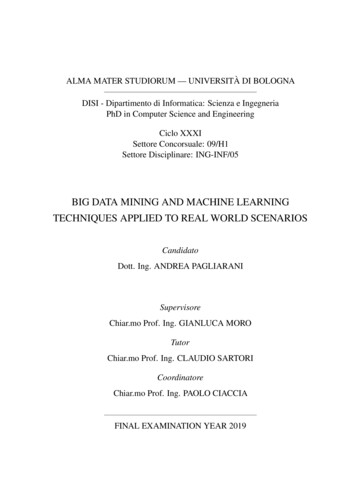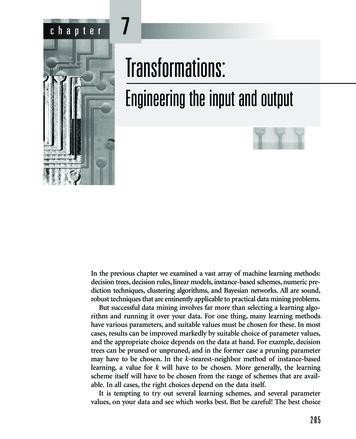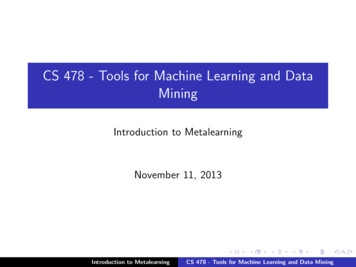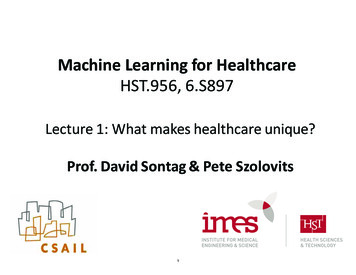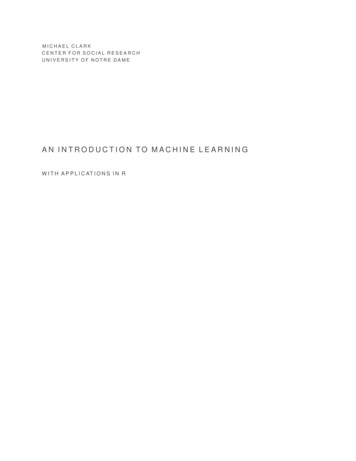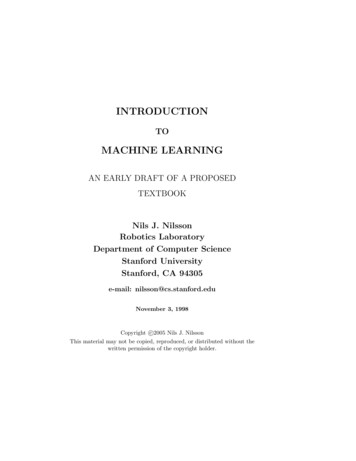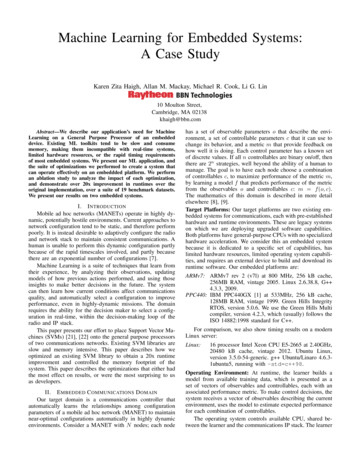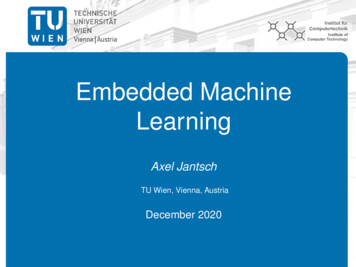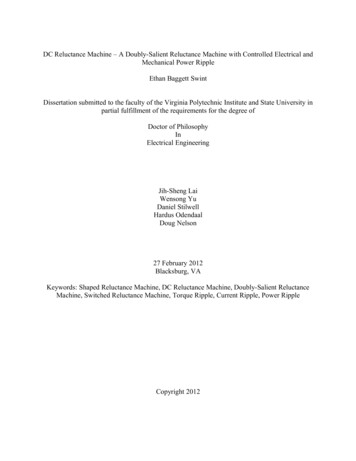
Transcription
DC Reluctance Machine – A Doubly-Salient Reluctance Machine with Controlled Electrical andMechanical Power RippleEthan Baggett SwintDissertation submitted to the faculty of the Virginia Polytechnic Institute and State University inpartial fulfillment of the requirements for the degree ofDoctor of PhilosophyInElectrical EngineeringJih-Sheng LaiWensong YuDaniel StilwellHardus OdendaalDoug Nelson27 February 2012Blacksburg, VAKeywords: Shaped Reluctance Machine, DC Reluctance Machine, Doubly-Salient ReluctanceMachine, Switched Reluctance Machine, Torque Ripple, Current Ripple, Power RippleCopyright 2012
DC Reluctance Machine – A Doubly-Salient Reluctance Machine with Controlled Electrical andMechanical Power RippleEthan Baggett SwintABSTRACTDoubly-Salient Reluctance Machines (DSRMs) sidestep many of the issues with permanentmagnet and induction machines and embody the lowest cost and simplest manufacturing of themotor technologies. Major drawbacks to RMs have been (1) the need for failure-proneelectrolytic capacitors, (2) large torque ripple, and (3) acoustic noise. Conventionally, thesedrawbacks have been addressed independently either through (1) excitation control or (2)machine design, but not as a holistic system or solution. This disseratation presents a design forhigh-efficiency low-cost RM while producing smooth output torque and avoiding pulsatinginverter input current and the associated electrolytic capacitor. We propose a method for shapingthe machine reluctance profile to reduce machine torque ripple to a desired level (here, 5%)without compromising on machine efficiency or power density, a Shaped Reluctance Machine(ShRM). Furthermore, a comprehensive approach which combines both phase excitation controland machine design to cooperatively address the excursions of input and output powers fromtheir average values which results in less than 5% ripple for both electrical and mechanical netpower – essentially a DC Reluctance Machine (DCRM). Compared to conventional practice inDSRMs, electrical power ripple is reduced by 85 times and torque ripple is reduced by almost 20times, while overall efficiency, torque density, and power density are maintained.
DedicationThis work is dedicated to my wife, Pamela, who stuck with it at times when I was ready tofold, to my daughter, Lily, who's constant nagging helped propel me to finish ('How's the robotmotor?', 'Is it moving?', 'How's the robot motor story?', 'Did you get your piece of paper?'), andmy son, Malcolm, who won't remember what the fuss was all about. And to my parents, Dr.Richard and Susan Swint, who always established high expectations and gave me the means andtools to achieve them.iii
AcknowledgmentThis work would not have been possible without Dr. Jih-Sheng Lai, whose generous andgracious support brought it back from the brink of abandonment. Dr. Richard Wallace, of theWhirlpool Corporation, whose technical (static torque curves) and emotional support moved theproject along. Seung-Ryul Moon obtained the static inductance measurements and is prepped toadvance the work in the lab. Also, the members of my advisory committee: Drs. Wen-song Yu,Daniel Stilwell, Hardus Odendaal, and Douglas Nelson, whose input and criticisms were greatlyappreciated and made for a better dissertation.My journey was enabled by the generous grant of Bradley Fellowship by the Via family inhonor of Harry Lynde Bradley. This award gave the freedom to pursue my interests and wascritical to the pursuit of my goals.iv
Table of ContentsChapter 1: Introduction.11.1 RM Fundamentals.41.2 Idealized RM.81.3 Power Ripple in RMs.101.3.1 Mechanical Power Ripple: Origins and Solutions.101.3.2 Electrical Power Ripple: Origins and Solutions.191.3.3 Combined Power Ripple: Solutions.251.4 Summary.26Chapter 2: Reluctance Shaping.272.1 Geometric parametrization.282.2 Perturbation process.312.2.1 Gap perturbation .312.2.2 Identification of torque perturbation .322.2.3 Gap-torque perturbation map.372.3 Design study in FEA .412.4 Summary.45Chapter 3: Excitation Shaping.48Chapter 4: DC Reluctance Machine Design.524.1 Selection of Perturbation Mode.534.2 Target Machine Specifications.544.3 Design Refinement Process with FEA.56v
4.4 Comparison to Conventional SRM.594.5 Summary.60Chapter 5: Experimental Results.615.1 Static Tests.625.2 Dynamic Tests.66Chapter 6: Conclusions.766.1 Summary.766.2 Contributions.786.3 Future Work.796.4 Conclusion.816.5 Publications.82References.83vi
List of FiguresFig. 1.1: The simplicity of construction is evident in the DSRM.2Fig. 1.2: Typical silicon steel BH curve [4].5Fig. 1.3: Idealized DSRM allows simple phase excitation strategy.8Fig. 1.4: Idealized DSRM produces constant torque with excitation from Fig. 1.11.9Fig. 1.5: Typical SRM torque ripple from FEA for three machines with the same average torqueoutput.11Fig. 1.6: Varied rotor pole widths [15].12Fig. 1.7: Wedge-shaped stator pole [17]. .12Fig. 1.8: Rectangular void at leading edge and addition at trailing edge [22].13Fig. 1.9: Rectangular cutout on rotor pole [23].14Fig. 1.10: Three pole profiles: tapered, sawtoooth, and chamfered. [12].14Fig. 1.11: Notch on pole side and linear r vs theta on face. [25].14Fig. 1.12: Pole face from non-concentric arc. [26].15Fig. 1.13: Continuous first derivative in rotor surface [27].15Fig. 1.14: Notch on side of rotor pole. [25].16Fig. 1.15: Interior void on rotor. [29].16Fig. 1.16: Net electrical power (green) sees a large peak-to-peak ripple and discontinuity underconventional excitation.19Fig. 1.17: A blocking diode in the drive prevents negative supply current [63].21Fig. 1.18: The control method described in [62] adds long tail currents to the outgoing phase(top), largely avoiding negative current from the course (bottom).22vii
Fig. 1.19: LC-filtered source input in [64].23Fig. 1.20: Simulated wave forms at 30% of rated power in [64].24Fig. 2.1: The original and modified gap function, due to a Gaussian perturbation.32Fig. 2.2: The original, modified and perturbation of the phase torque due to a Gaussianperturbation of the gap function, g. .33Fig. 2.3: The torque perturbation and its Gaussian estimate.36Fig. 2.4: Map between Gaussian centers.38Fig. 2.5: Map between Gaussian magnitudes.39Fig. 2.6: Map between Gaussian widths.40Fig. 2.7: Torque error and its Gaussian model.42Fig. 2.8: Evolution of machine during refinement, clockwise from top left: gap function, torque,core loss, phase power, and phase current.44Fig. 3.1: The effects of perturbation of excitation voltage on other machine waveforms.51Fig. 4.1: Lamination design for 3-phase, 12/16 machine.55Fig. 4.2: Initial electrical (top) and mechanical (bottom) power wave forms for a conventionalthree-phase SRM.57Fig. 4.3: Final electrical (left) and mechanical (right) power wave forms for a three-phaseDCRM.57Fig. 4.4: Air gap of DCR, in relation to that of the ShRM in Chapter 3.58Fig. 5.1: The prototype machine.62Fig. 5.2: Experimental vs modeled static torque waveforms at various currents.63Fig. 5.3: Phase inductance measurements for the prototype machine.64viii
Fig. 5.4: Using the final current profile from the FEA refinement process (left), the per-phase andnet torque (right) are calculated based on the static torque waveforms .65Fig. 5.5: Dynamometer setup for dynamic testing of prototype DCRM.67Fig. 5.6: The DCRM is driven by a conventional asymmetric half-bridge converter andconnected to the DC voltage source through an LC low-pass filter.67Fig. 5.7: Block diagram of DCRM controller.68Fig. 5.8: Raw experimental waveforms for 3 load points.69Fig. 5.9: Isolation of the phase frequency harmonics.69Fig. 5.10: Filtered experimental waveforms for 3 load points.71Fig. 5.11: Machine efficiency at various load points.73ix
List of TablesTable I FEA Ref
Doubly-Salient Reluctance Machines (DSRMs) sidestep many of the issues with permanent magnet and induction machines and embody the lowest cost and simplest manufacturing of the motor technologies. Major drawbacks to RMs have been (1) the need for failure-prone electrolytic capacitors, (2) large torque ripple, and (3) acoustic noise .


